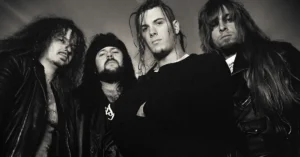Anthrax: Thrash Metal Titans with a Unique Legacy
Anthrax. Formation and Early Years (1981-1984)
Anthrax. The Birth of Anthrax
Anthrax was formed in 1981 in New York City by guitarist Scott Ian. Along with Ian, the band’s early lineup included guitarist Dan Spitz, bassist Danny Lilker, drummer Kenny Hickey, and vocalist Neil Turbin. The band was inspired by the burgeoning thrash metal scene, combining the fast, aggressive guitar riffs of early heavy metal with the intense energy of punk rock.
Anthrax was one of the founding members of the Big Four of Thrash Metal, alongside Metallica, Slayer, and Megadeth, and they quickly became known for their energetic performances and a style that was uniquely their own.

Anthrax. The Rise to Recognition: 1984-1987
“Fistful of Metal” (1984)
In 1984, Anthrax released their debut album, Fistful of Metal (1984), under the Megaforce Records label. The album was an aggressive, fast-paced introduction to their thrash style, though it did not yet display the full range of the band’s musical prowess. With tracks like “Deathrider” and “Metal Thrashing Mad,” the album was well-received in the underground metal scene, but it didn’t quite break into the mainstream yet.
The album featured Neil Turbin on vocals, whose high-pitched screams became a trademark of the band’s early sound. Although Fistful of Metal was a strong debut, it didn’t gain the widespread recognition that would come with subsequent releases.
“Spreading the Disease” (1985)
Anthrax’s second album, Spreading the Disease (1985), marked the arrival of vocalist Joey Belladonna. His powerful, clean vocals contrasted with Turbin’s higher-pitched screams, adding a new dimension to the band’s sound. This album was a major step forward for the band, showcasing their ability to blend thrash metal with more melodic elements, a move that helped set them apart from other thrash bands at the time.
Tracks like “Madhouse” and “A.I.R.” demonstrated the band’s growing musical complexity, while the album’s lyrics delved into themes of chaos, paranoia, and societal collapse. Spreading the Disease is often regarded as one of Anthrax’s best albums, gaining the band a wider fanbase and critical recognition.
The Thrash Era: 1987-1990
“Among the Living” (1987)
In 1987, Anthrax released Among the Living (1987), one of their most influential albums. The album featured a tighter sound, with faster tempos and even more sophisticated songwriting. Among the Living was a defining album for the band, establishing them as one of the leading voices in thrash metal.
The album’s title track, along with “Caught in a Mosh” and “Indians,” became thrash anthems and have remained staples of the band’s live performances ever since. Among the Living explored darker themes, including war, nuclear devastation, and personal struggle, often with an anti-authoritarian slant. It was a critical and commercial success, cementing Anthrax’s place as a thrash metal titan.
“State of Euphoria” (1988)
Anthrax’s follow-up album, State of Euphoria (1988), continued in the same vein as Among the Living but with a slightly more accessible sound. The album featured the hit single “Antisocial,” a cover of the French band Trust, which became a standout track in the band’s career. The album also produced tracks like “Be All, End All” and “Who Cares Wins,” demonstrating the band’s ability to craft more melodic, yet still aggressive, thrash songs.
While State of Euphoria was well-received, it didn’t quite match the heights of Among the Living in terms of critical acclaim, but it still helped the band to further establish their identity in the thrash metal scene.
Anthrax. The 90s: Changes and Challenges
“Persistence of Time” (1990)
In 1990, Anthrax released Persistence of Time, an album that marked a return to a heavier, more mature sound. The album’s more serious tone and lyrics reflected the band’s evolution as musicians. Tracks like “Got the Time” (a cover of Joe Jackson’s song), “Blood,” and “Keep It in the Family” showcased Anthrax’s ability to incorporate more intricate rhythms and melodies while staying true to their thrash roots.
The album also featured some of the band’s heaviest and most aggressive material to date, and it continued to push the boundaries of thrash. Persistence of Time was a success, earning positive reviews and further solidifying Anthrax’s reputation as one of the leaders in thrash metal.
The Shift in Sound: The 1990s
As the 1990s progressed, thrash metal faced challenges as grunge and alternative rock began to take over the mainstream. During this time, Anthrax went through several lineup changes, most notably the departure of guitarist Dan Spitz and the introduction of new musical influences. The band’s experimentation with different sounds led to albums like Sound of White Noise (1993) and Stomp 442 (1995), which saw a departure from their classic thrash style.
Though these albums had some notable moments, they marked a period of transition for the band, as they navigated changes in the music industry and sought to redefine themselves.
The Return to Form: 2000s-Present
“We’ve Come for You All” (2003)
In 2003, Anthrax returned with We’ve Come for You All, which featured a mix of old-school thrash and newer influences. The album received critical acclaim for its return to the band’s roots, blending the aggressive thrash sound with more modern elements. Tracks like “Safe Home” and “Nobody Knows Anything” were praised for their complexity and energy.
The album also marked the return of original guitarist Dan Spitz, who had rejoined the band, providing a sense of continuity and old-school chemistry.
“For All Kings” (2016)
In 2016, Anthrax released For All Kings, which was hailed as a triumphant return to form. The album combined elements of thrash with more melody and technical precision, showcasing the band’s growth over the years. For All Kings proved that Anthrax was still a major force in the heavy metal world, with songs like “Breathing Lightning” and “Evil Twin” reminding fans why the band had remained relevant for so many decades.
Anthrax. Legacy and Influence
Anthrax’s impact on thrash metal and the broader heavy metal genre cannot be overstated. As one of the “Big Four” thrash bands, alongside Metallica, Slayer, and Megadeth, Anthrax helped define the sound and ethos of thrash metal in the 1980s and beyond.
Their combination of speed, technicality, and social commentary has influenced countless bands in the heavy metal and thrash scenes. They have also been praised for their sense of humor and willingness to experiment with different sounds, while always maintaining their core identity as thrash pioneers.
Discography Highlights
| Year | Album | Notable Tracks |
|---|---|---|
| 1984 | Fistful of Metal | “Deathrider,” “Metal Thrashing Mad” |
| 1985 | Spreading the Disease | “Madhouse,” “A.I.R.” |
| 1987 | Among the Living | “Caught in a Mosh,” “Indians” |
| 1988 | State of Euphoria | “Antisocial,” “Be All, End All” |
| 1990 | Persistence of Time | “Got the Time,” “Blood” |
| 1993 | Sound of White Noise | “Only,” “Black Lodge” |
| 2003 | We’ve Come for You All | “Safe Home,” “Nobody Knows Anything” |
| 2016 | For All Kings | “Breathing Lightning,” “Evil Twin” |
Interesting Facts About Anthrax
- Joey Belladonna’s Return: Joey Belladonna, the band’s iconic vocalist, rejoined Anthrax in 2005, bringing the classic lineup back together and returning to the band’s roots.
- Anthrax’s Influence on Metalcore: Anthrax has been a major influence on the development of metalcore and thrashcore, genres that combine thrash metal with hardcore punk elements.
- Comedy and Humor: Despite their intense and often dark music, Anthrax has always had a sense of humor, which is evident in their music videos and live performances. They’ve been known to have fun with their image, while still delivering powerful music.





